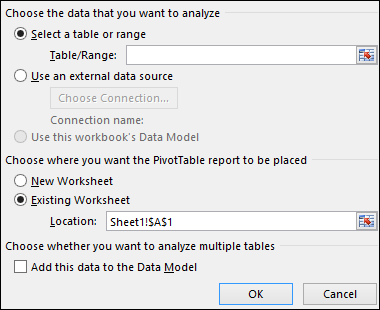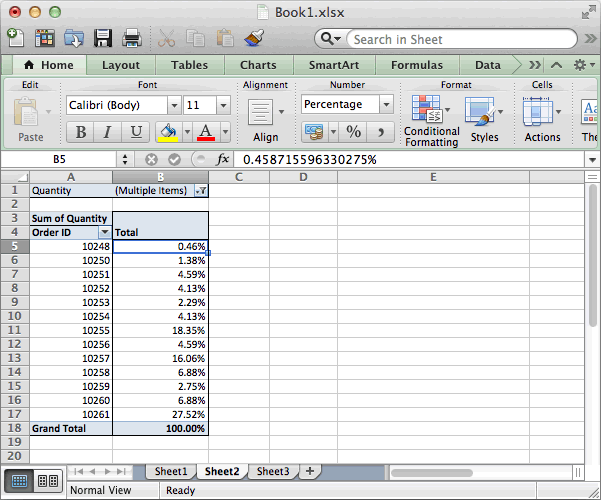Microsoft Excel For Mac 2019 Pivot Table
Excel 2019 makes it simple to create a new pivot table using a data list selected in your worksheet with its Quick Analysis tool. To preview various types of pivot tables that Excel can create for you on the spot using the entries in a data list that you have open in an Excel worksheet, simply follow these steps:
- Select all the data (including the column headings) in your data list as a cell range in the worksheet.
If you’ve assigned a range name to the data list, you can select the column headings and all the data records in one operation simply by choosing the data list’s name from the Name box drop-down menu.
- Click the Quick Analysis tool that appears right below the lower-right corner of the current cell selection.
Doing this opens the palette of Quick Analysis options with the initial Formatting tab selected and its various conditional formatting options displayed. - Click the Tables tab at the top of the Quick Analysis options palette.
Excel selects the Tables tab and displays its Table and PivotTable option buttons. The Table button previews how the selected data would appear formatted as a table. The other PivotTable buttons preview the various types of pivot tables that can be created from the selected data. - To preview each pivot table that Excel 2019 can create for your data, highlight its PivotTable button in the Quick Analysis palette.
As you highlight each PivotTable button in the options palette, Excel’s Live Preview feature displays a thumbnail of a pivot table that can be created using your table data. This thumbnail appears above the Quick Analysis options palette for as long as the mouse or Touch pointer is over its corresponding button. - When a preview of the pivot table you want to create appears, click its button in the Quick Analysis options palette to create it.
Excel 2019 then creates the previewed pivot table on a new worksheet that is inserted at the beginning of the current workbook. This new worksheet containing the pivot table is active so that you can immediately rename and relocate the sheet as well as edit the new pivot table, if you wish.
In Power Pivot. Import data from different sources, such as large corporate databases, public data feeds, spreadsheets, and text files on your computer. Import all data from a data source. Filter data and rename columns and tables while importing. Read about Get data using the Power Pivot add-in. Create tables. I have a pivot table set up, and have selected 'Preserve cell formatting on update' in PivotTable Option. However, when I select a different slicer or refresh the data, the cell formats change dramatically and seemingly randomly. I cannot get the table to save the cell format consistently.
- Click the PivotChart command button in the Tools group on the Analyze tab under the PivotTable Tools contextual tab to open the Insert Chart. Click the thumbnail of the type of chart you want to create in the Insert Chart dialog box and then click OK.
- Use Excel 2019 pivot tables and pivot charts to produce powerful, dynamic reports in minutes instead of hours, to take control of your data and your business. Even if you’ve never created a pivot table before, this book will help you leverage all their remarkable flexibility and analytical power–including valuable improvements in Excel 2019 and Excel in Office 365.
- Hello all, I have a question on Pivot Tables and Charts. I want to know how to add new data to a Pivot Table when you have already completed a Pivot Table chart. For instance, on the Pivot Table I used names of states and numbers of female to male doctor ratios within that state.
The following figures show you how this procedure works. In the first figure, the fourth suggested PivotTable button in the Quick Analysis tool’s option palette is highlighted. The previewed table in the thumbnail displayed above the palette shows the salaries subtotals and grand totals in the Employee Data list organized whether or not the employees participate in profit sharing (Yes or No).
The second figure shows you the pivot table that Excel created when I clicked the highlighted button in the options palette in the preceding figure. Note this pivot table is selected on its own worksheet (Sheet1) that’s been inserted in front of the Employee Data worksheet. Because the new pivot table is selected, the PivotTable Fields task pane is displayed on the right side of the Excel worksheet window and the PivotTable Tools context tab is displayed on the Ribbon. You can use the options on this task pane and contextual tab to then customize your new pivot table.
Note that if Excel can’t suggest various pivot tables to create from the selected data in the worksheet, a single Blank PivotTable button is displayed after the Table button in the Quick Analysis tool’s options on the Tables tab. You can select this button to manually create a new pivot table for the data.
The Mark as Date Table dialog box appears when you click Mark as Date Table button or choose Date Table Settings in the Design tab of the Power Pivot window. With the Mark as Date Table dialog box, you specify a unique date column, which enables the use of advanced date filters against Power Pivot data in Excel pivot reports.

Unity Animator Trigger
Advanced date filters appear for row and column labels in a PivotTable or PivotChart when you add a field from the date table to the Row Labels or Column Labels of the Power Pivot field list.
To change the date properties
In the Power Pivot window, select a table that contains dates.
In the Design tab, click Mark as Date Table. Microsoft download manager for mac.
In the dialog box, select a column that contains unique values, with no blank values.
Click OK.

To use advanced date filters
Excel Pivot Table Tutorial
Navigate to a PivotTable or PivotChart in the same workbook.
Add a column from the Date table to the Column Labels or Row LabelsMac microsoft office. area of the Power Pivot field list.
Click the down arrow next to Column Labels or Row Labels in the PivotTable.
Point to Date Filters, and then select a filter from the list.